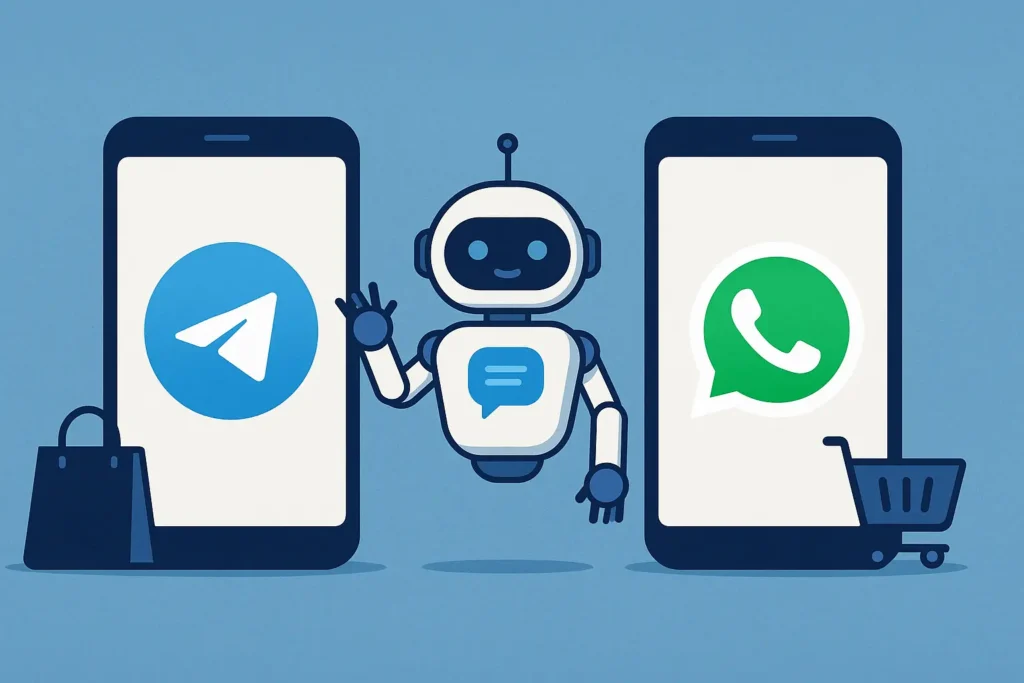In 2025, AI chatbots have become an essential part of e-commerce. Customers no longer tolerate waiting hours for a reply or jumping through hoops to get information. They expect instant answers, personalized shopping recommendations, and smooth purchase flows. That is why businesses are increasingly turning to platforms like WhatsApp and Telegram to power their chatbot strategies.
Both platforms offer different strengths, but they also come with important trade-offs. WhatsApp is the global giant with unmatched reach, while Telegram is known for its speed, flexibility, and developer-friendly ecosystem. In this article, we will break down Telegram vs WhatsApp for e-commerce chatbots, explore real use cases, and show how MisterChatter makes Telegram chatbot setup simple and effective.
Why E-commerce Needs AI Chatbots in 2025
E-commerce today is hyper-competitive, and customer experience often makes the difference between a sale and a lost opportunity. AI chatbots help brands scale by offering support and sales conversations around the clock. According to reports from Amio, businesses save up to 60 percent in support costs and see over 20 percent higher conversions with AI-driven chat automation.
Customers value,
- 24/7 instant replies that remove the frustration of waiting
- Personalized guidance through product catalogs or checkout flows
- Multilingual support for international buyers
- Smooth escalation from AI to human when needed
This combination of savings and improved customer experience explains why chatbots are becoming standard in both Telegram and WhatsApp ecosystems.
WhatsApp AI Chatbots for E-Commerce
WhatsApp is the most widely used messaging platform, with over 2.7 billion users worldwide. Its dominance in markets like Latin America, India, and parts of Europe makes it an obvious choice for businesses that want to reach a broad audience.
The advantages of WhatsApp bots are clear. Verified business profiles build trust with customers. The platform allows businesses to set up catalogs and shopping experiences inside the app. It integrates well with CRMs and backend systems, making it useful for structured customer service. In highly regulated industries such as banking, travel, or healthcare, WhatsApp’s reputation for compliance and security is also a strong factor.
However, there are challenges. WhatsApp bots require Meta approval and template submissions before going live. Businesses also face per-conversation or per-message fees through the WhatsApp Business API. This pricing model can make scaling expensive. Flexibility is also limited since Meta controls what is allowed, which restricts innovation in automation. Many small e-commerce owners find the process complex and time-consuming compared to alternatives.
Telegram AI Chatbots for E-Commerce
Telegram has grown quickly and now has over 1 billion active users. Its rise is fueled by its open API, speed of innovation, and independence from large corporate control. For e-commerce brands, Telegram offers an appealing environment for building chatbots.
One of the biggest advantages is ease of setup. Unlike WhatsApp, no approvals or templates are required. You simply generate a bot token with BotFather and connect it to your system. There are no per-message fees at the API level, which makes Telegram significantly more cost-effective.
Telegram bots are also highly flexible. Businesses can send broadcasts, create mini apps, use inline menus, and integrate bots into groups or channels. Such.chat highlights features like quick AI to human handoff and product wikis directly inside the app. Communities thrive on Telegram, making it a natural fit for startups, digital product sellers, and subscription-based e-commerce.
This is where MisterChatter adds even more value. It takes Telegram’s open ecosystem and simplifies it into a five-minute setup process, letting any business create a human-like AI chatbot without coding.
Telegram vs WhatsApp Feature Comparison
The two platforms have distinct advantages and limitations. The table below shows the key differences, followed by a short explanation to help you understand the trade-offs more clearly.
| Aspect | WhatsApp AI Chatbot | Telegram AI Chatbot |
| User base | Leads with over 2.7 billion global users | Around 1 billion users and growing quickly |
| Setup time | Requires approvals and business verification | Instant setup with a bot token, no approvals needed |
| Cost model | Charges per conversation via WhatsApp Business API | Free to use via API, businesses only cover hosting and AI processing |
| Flexibility | Restricted by Meta rules, limited customization | Supports mini apps, broadcasts, and custom automations |
| Privacy & control | Tied to Meta and subject to its policies | Independent, with more autonomy over integrations and data flow |
In short, WhatsApp delivers unmatched reach and compliance benefits, while Telegram stands out for speed, flexibility, and affordability.
Best Use Cases for WhatsApp AI Chatbots
WhatsApp is well-suited for industries where compliance and trust are non-negotiable. Businesses in finance, healthcare, and logistics often prefer WhatsApp because of its verified profiles and structured workflows. It is also valuable in markets where WhatsApp is the default messenger, giving businesses direct access to almost every customer.
For enterprises needing large-scale integrations with CRMs and official customer communication, WhatsApp remains the safe choice despite its higher costs and longer setup times.
Best Use Cases for Telegram AI Chatbots
Telegram excels in environments where speed, flexibility, and cost matter most. Fast-scaling startups and direct-to-consumer brands use Telegram bots to handle customer support, run loyalty groups, and sell digital products. Sellers of subscriptions, memberships, or VIP services also benefit from Telegram’s group and channel features.
Community-driven industries such as crypto, education, and gaming lean heavily on Telegram for engagement. For e-commerce owners who want to experiment and innovate quickly, Telegram is the better choice. MisterChatter makes it even easier by offering pre-built flows for sales, support, and customer retention that can be launched in minutes.
Cost and Setup Time
The difference in cost and setup speed is one of the most important factors for small and mid-sized businesses. WhatsApp requires Meta approval, template submissions, and onboarding with a business solution provider. This process can take days or weeks, and ongoing costs can add up quickly.
Telegram is the opposite. Setup is immediate and free, with no approvals needed. With MisterChatter, businesses can go from zero to live bot in under five minutes. That kind of speed can be the difference between capturing sales today and losing customers tomorrow.
Privacy and Control
Both platforms value user security but in different ways. WhatsApp provides end-to-end encryption for chats, but businesses are tied to Meta’s policies and data practices. Any change in pricing or regulations can affect how businesses operate.
Telegram, while not end-to-end encrypted by default, gives businesses more autonomy over how bots are built, integrated, and scaled. For brands that want control and independence, Telegram is the stronger option.
MisterChatter Implementation Guide
Getting started with MisterChatter on Telegram is simple. Here is the step-by-step process:
Create a bot token using Telegram’s BotFather.
Set Up a New Agent in MisterChatter
By completing the first two steps your MisterChatter is now connected with the bot. To configure your messages and connect the bot to a group, see the detailed instructions in the MisterChatter Docs.
Unlike WhatsApp, there are no approvals, fees, or barriers. You get the freedom to design a chatbot that matches your brand without restrictions.
Frequently Asked Questions
The main differences are in setup, cost, flexibility, and control. WhatsApp involves a stricter approval process and per-conversation costs. Telegram allows open API access, more custom flows, and fewer restrictions.
It depends on your target market and requirements. If reach and trust in regulated sectors matter, WhatsApp is strong. But for fast growth, low cost, and control, Telegram often wins.
Minimal. Using Telegram’s bot API is free at the message level. Your costs come from infrastructure, AI processing, and hosting – not the messaging itself.
Yes. You can build full flows: browse catalogs, take orders, answer support queries, escalate to humans, manage subscriptions or digital goods.
Use Telegram’s BotFather to create a bot token, then connect it to your backend or a platform (like MisterChatter). Follow flow definition, add AI / automations, test, then launch. You can refer to MisterChatter’s docs for a full step-by-step guide.
Conclusion
Both WhatsApp and Telegram AI chatbots can play important roles in e-commerce. WhatsApp offers unmatched global reach and credibility, especially in compliance-driven industries. Telegram, however, wins on speed, cost, and flexibility. For the majority of modern e-commerce businesses, Telegram is the better option.
With MisterChatter, you can set up your Telegram AI chatbot quickly and unlock the benefits of 24/7 customer support and sales automation without the complexity or expense of WhatsApp.
Start 10-day free trial with MisterChatter and experience how simple AI-powered e-commerce can be.


